High Precision Positioning Research: four forms of mass-produced integrated high-precision positioning products
With the continuous development of autonomous driving, the demand for high-precision positioning technology is increasing. As intelligent vehicles tend to pre-embed hardware, ever more passenger cars are equipped with high-precision positioning hardware. After mass production and delivery, higher-level functions can be realized via OTA updates.
Suppliers accelerate mass production and installation of high-precision positioning products as a standard configuration of vehicles
An impressive number of models launched from 2022 are equipped with high-precision positioning technology. Among them, NIO, Xpeng, Li Auto, Hozon, Human Horizons, and BAIC ARCFOX offer high-precision positioning as a standard configuration on their new models in 2022. Conventional OEMs have also accelerated their deployment, for instance, Great Wall Tank 500, Great Wall Mecha Dragon, Changan Deep Blue SL03, SAIC Rising Auto R7, SAIC MAXUS G90, Chery JETOUR Dasheng, Cadillac LYRIQ have unveiled versions with standard high-precision positioning and those with optional high-precision positioning. According to the statistics of ResearchInChina, China mass-produced more than 280,000 passenger cars equipped with high-precision positioning from January to October 2022, with the installation rate of about 1.8%.
Large-scale installation of high-precision positioning in vehicles, especially centimeter-level high-precision positioning that meets L4/L5 requirements, will be only achieved on the premise of higher positioning accuracy through high-precision positioning services (such as RTK/PPP-RTK) and lower costs. For high-precision positioning suppliers, independent development of core software and hardware can significantly reduce costs.
(1) Basic positioning service technology
The fusion of high-precision positioning hardware technology with RTK or PPP-RTK technology can effectively improve positioning accuracy, realize centimeter-level positioning and cater to the requirements of different levels of autonomous driving. At present, Chinese vendors such as Qianxun SI, Sixents Technology, China Mobile, and Beidou TruePoint can provide RTK or PPP-RTK positioning services to help OEMs develop autonomous driving.
Sixents Technology: so far, it has built more than 2,800 CORS base stations in China, self-developed terminal RTK algorithms and integrated navigation algorithms. Based on the principle of virtual reference stations and precise single-point positioning technology, it has developed its own "Yunge" computing platform to calculate various spatial errors and build a "network-cloud-terminal" integrated solution through its self-developed terminal RTK algorithms and terminal integrated navigation algorithms. This solution will be able to provide all-weather, real-time centimeter-level high-precision positioning services with 5 systems and 16 frequency points. The high-precision positioning services of Sixents Technology can achieve integrity monitoring and integrity output from satellite to cloud, and to terminals.
In the past two years, Sixents Technology has secured a number of orders from WM Motor, Inceptio Technology and TuSimple in the field of intelligent driving, and has built cooperation with many upstream and downstream enterprises of Beidou, such as Dongfeng Yuexiang, Autowise, DiDi Bike, INTEST, u-blox and Kunchen.
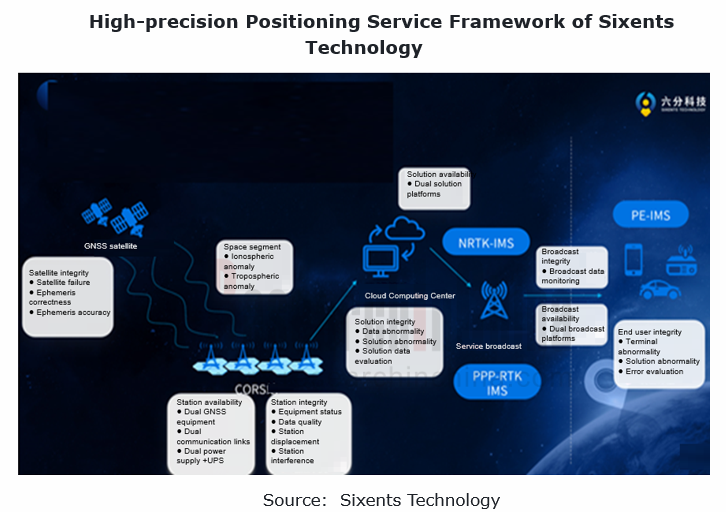
DAYOUPi: in early January 2023, it officially launched the PPP-RTK global satellite positioning service. Through comprehensive processing of base station data, it establishes error models such as ionospheric delay and tropospheric delay of the entire network, and generates a set of state corrections including satellite orbit, clock difference, ionosphere, etc., and sends it to the vehicle for position calculation, with rapid convergence in less than 30 seconds and positioning accuracy of 2cm.
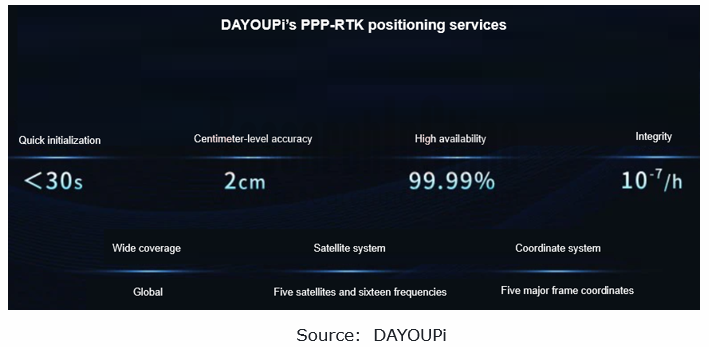
PPP-RTK embodies apparent advantages in the market, and features integrity of positioning result output:
1.Short convergence time: atmospheric corrections and phase fractional bias products provided by ground-based reference networks are exploited to achieve fast convergence;
2.Strong privacy: terminal location data need not to be uploaded to operator platforms;
3.Wide coverage: mobile communication and satellite broadcasting are supported simultaneously and can complement each other to achieve global positioning;
4.Effective cost reduction: in view of the low communication bandwidth requirements, satellite broadcasting can be used, because the amount of calculation and broadcast data hereby does not increase in a linear manner, with the hike in the number of users. In addition, the demand for base stations is relatively low, which can effectively reduce the corresponding costs;
At present, PPP-RTK technology is an effective solution to the problems about costs and positioning accuracy. It is expected to gradually become the preferred technology enabling high-precision positioning services in the intelligent driving solutions of OEMs.
(2) Positioning hardware products
As for GNSS localization, China-based BYNAV Technology, CHCNAV, Qianxun SI, and Unicore Communications have all self-developed chips or board cards.
Unicore Communications: the Beidou high-precision positioning module UM982, launched in July 2022, is designed based on the NebulasIV chip developed by Unicore Communications independently. It enables RTK positioning and dual-antenna directional calculation. NebulasIV integrates all RF information processing, baseband signal capture and tracking, high-precision centimeter-level algorithms, anti-jamming algorithms, etc. It is a 22nm GNSS SoC combining RF baseband with high-precision algorithms.
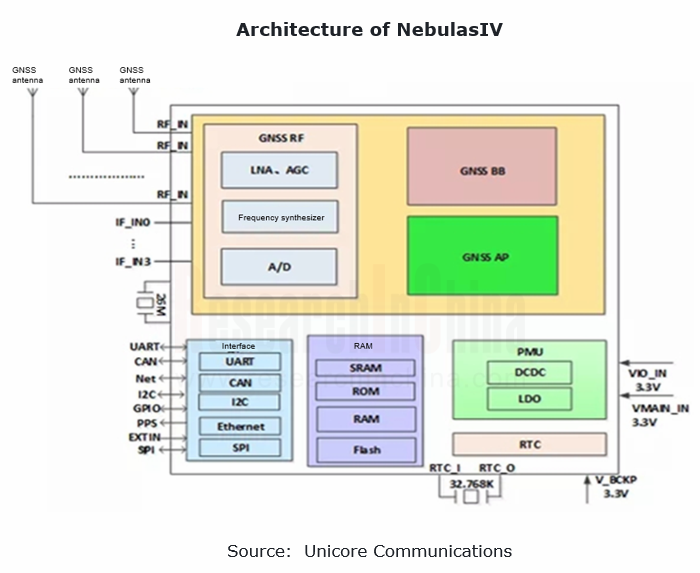
In terms of IMU localization, Chinese vendors such as DAISCH, Asensing and W-Ibeda have mass-produced IMU modules, while foreign vendors still dominate IMU chips.
High-precision positioning boxes (P-Box) have been mass-produced and installed in vehicles.
High-precision positioning hardware for mass-produced passenger cars mainly includes the following four integrated product forms: (1) Independent positioning boxes such as P-Box and Map-Box; (2) SMD modules that integrate high-precision positioning into T-Box or domain controllers; (3) GNSS/IMU integrated into T-Box (wireless communication module); (4) GNSS and IMU modules that are separately deployed in different positions in the vehicle.
Since P-Box can be quickly integrated into vehicles, it has become the best choice for most OEMs, especially conventional OEMs, to mass-produce and install high-precision positioning swiftly.
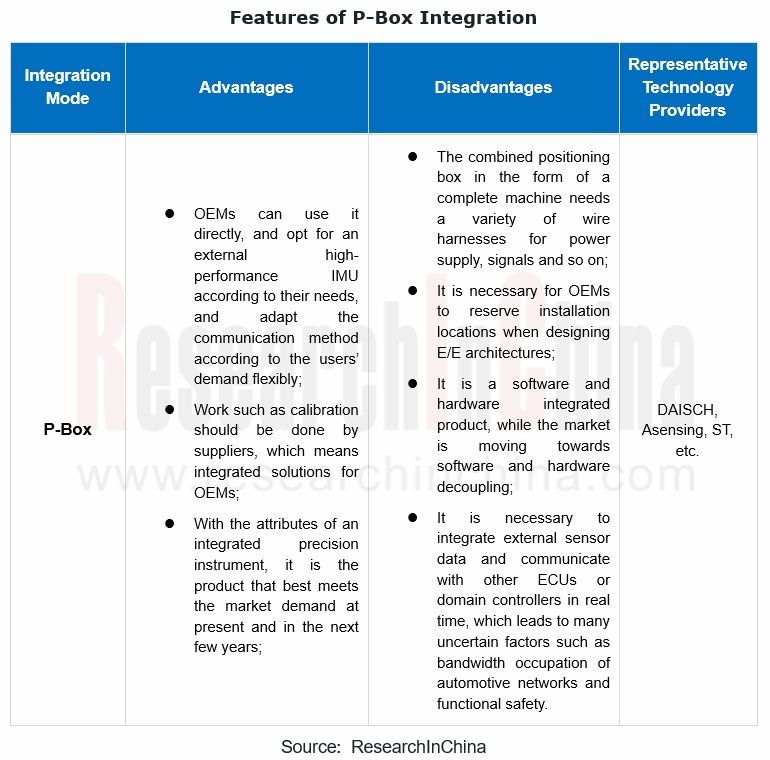
STMicroelectronics: at the electronica South China in November, 2022, ST exhibited its P-Box, which consists of ST's multi-frequency multi-constellation GNSS chip (STA9100/STA8100), positioning engine (STA1835), IMU (ASM330LHB) and power management system (LDO DC-DC L5965). It can realize lane-level positioning.
ST's P-Box complies with ASIL- B, with the GNSS chip involved conforming to ASIL-B. The positioning engine, power management system and IMU all support ASIL-B automotive applications.
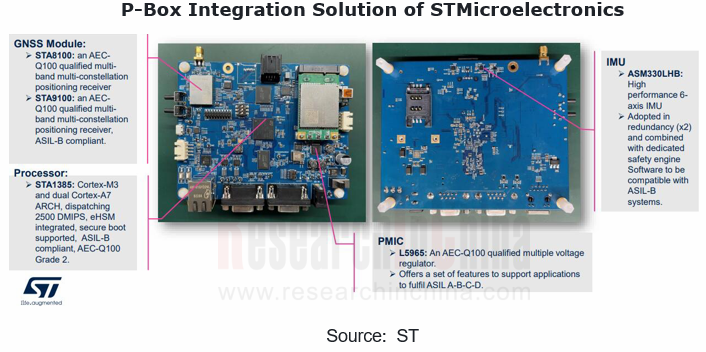
Asensing: Focusing on the high-precision positioning industry, Asensing’s high-precision positioning solutions satisfy ISO 26262. The P-Box of Asensing integrates MEMS inertial navigation technology, RTK-GNSS and vehicle information (wheel speed, gear position, etc.), which conforms to ISO 26262 ASIL B.
Li L9, which went on the market in June 2022, and Changan Deep Blue SL03, which was unveiled in July 2022, are all equipped with Asensing’s P-Box. In addition, Asensing has been designated by Chery for its project.
The evolution of E/E architectures promotes the development of SMD positioning modules
OEMs that can develop their own algorithms have begun to explore the integration of high-precision positioning into the intelligent driving domain to reduce the use of wiring harnesses and interfaces. In order to follow the development trend for domain centralization and multi-domain fusion architectures, suppliers are aggressively deploying SMD high-precision positioning products in addition to P-Box. At present, BYNAV Technology, Aceinna, U-blox, etc. have introduced SMD high-precision positioning modules.
U-blox: in November 2022, u-blox announced the u-blox ZED-F9K-01A, a high-precision GNSS module with embedded advanced hardware, software, and latest generation IMU to provide an advanced, self-contained positioning solution.
The u-blox ZED-F9K-01A natively supports the u-box PointPerfect GNSS augmentation service. It delivers multiple GNSS and IMU outputs in parallel to support all possible architectures, including a 50 Hz sensor-fused solution with very low latency. Operation up to 105 oC makes it possible to integrate the product anywhere in the car without design constraints.
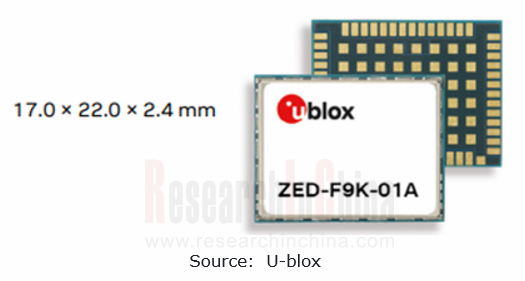
Automotive High-precision Positioning Industry Research Report, 2023 by ResearchInChina highlights the following:
 High-precision positioning industry policy, market size, market structure, etc.;
High-precision positioning industry policy, market size, market structure, etc.;
 The development, providers and products of main high-precision positioning technologies (including GNSS, IMU, GNSS+RTK+IMU, etc.);
The development, providers and products of main high-precision positioning technologies (including GNSS, IMU, GNSS+RTK+IMU, etc.);
 Development trends of of main high-precision positioning technologies, including automotive integration modes, fusion algorithms and application of PPP-RTK technology;
Development trends of of main high-precision positioning technologies, including automotive integration modes, fusion algorithms and application of PPP-RTK technology;
 High-precision positioning in main application scenarios (including production passenger cars, autonomous delivery, autonomous trucks, etc.) and the size of market segments;
High-precision positioning in main application scenarios (including production passenger cars, autonomous delivery, autonomous trucks, etc.) and the size of market segments;
 Main technologies, products, competitive advantages and cooperation of basic high-precision positioning service providers and positioning module suppliers.
Main technologies, products, competitive advantages and cooperation of basic high-precision positioning service providers and positioning module suppliers.
OEMs and Tier 1 Suppliers' Cost Reduction and Efficiency Enhancement Strategy Analysis Report, 2025
ResearchInChina released the "OEMs and Tier 1 Suppliers' Cost Reduction and Efficiency Enhancement Strategy Analysis Report, 2025", summarizing hundreds of cost reduction strategies to provide referen...
Automotive Fixed Panoramic Sunroof and Smart Roof Research Report, 2025
With the intelligent application of car roofs as the core, this report systematically sorts out a series of new products such as fixed panoramic sunroof/openable sunroof, ceiling screen, roof ambient ...
Automotive-Grade Power Semiconductor and Module (SiC, GaN) Industry Research Report, 2025
SiC/GaN Research: Sales volume of 800V+ architecture-based vehicles will increase more than 10 times, and hybrid carbon (SiC+IGBT) power modules are rapidly being deployed in vehicles.
Sales volume o...
Cockpit Agent Engineering Research Report, 2025
Cockpit Agent Engineering Research: Breakthrough from Digital AI to Physical AI
Cockpit Agent Engineering Research Report, 2025 starts with the status quo of cockpit agents, summarizes the technical ...
Prospective Study on L3 Intelligent Driving Technology of OEMs and Tier 1 Suppliers, 2025
L3 Research: The Window of Opportunity Has Arrived - Eight Trends in L3 Layout of OEMs and Tier 1 Suppliers
Through in-depth research on 15 OEMs (including 8 Chinese and 7 foreign OEMs) and 9 Tier 1 ...
China Commercial Vehicle IoV and Intelligent Cockpit Industry Research Report 2025
Commercial Vehicle IoV and Cockpit Research: The Third Wave of Passenger Car/Commercial Vehicle Technology Integration Arrives, and T-Box Integrates e-Call and 15.6-inch for Vehicles
I. The third wav...
Intelligent Vehicle Electronic and Electrical Architecture (EEA) and Technology Supply Chain Construction Strategy Research Report, 2025
E/E Architecture Research: 24 OEMs Deploy Innovative Products from Platform Architectures to Technical Selling Points
According to statistics from ResearchInChina, 802,000 passenger cars with domain...
Research Report on Intelligent Vehicle Cross-Domain Integration Strategies and Innovative Function Scenarios, 2025
Cross-Domain Integration Strategy Research: Automakers' Competition Extends to Cross-Domain Innovative Function Scenarios such as Cockpit-Driving, Powertrain, and Chassis
Cross-domain integration of ...
China Autonomous Driving Data Closed Loop Research Report, 2025
Data Closed-Loop Research: Synthetic Data Accounts for Over 50%, Full-process Automated Toolchain Gradually Implemented
Key Points:From 2023 to 2025, the proportion of synthetic data increased from 2...
Automotive Glass and Smart Glass Research Report, 2025
Automotive Glass Report: Dimmable Glass Offers Active Mode, Penetration Rate Expected to Reach 10% by 2030
ResearchInChina releases the Automotive Glass and Smart Glass Research Report, 2025. This r...
Passenger Car Brake-by-Wire (BBW) Research Report, 2025
Brake-by-Wire: EHB to Be Installed in 12 Million Vehicles in 2025
1. EHB Have Been Installed in over 10 Million Vehicles, A Figure to Hit 12 Million in 2025.
In 2024, the brake-by-wire, Electro-Hydr...
Autonomous Driving Domain Controller and Central Computing Unit (CCU) Industry Report, 2025
Research on Autonomous Driving Domain Controllers: Monthly Penetration Rate Exceeded 30% for the First Time, and 700T+ Ultrahigh-compute Domain Controller Products Are Rapidly Installed in Vehicles
L...
China Automotive Lighting and Ambient Lighting System Research Report, 2025
Automotive Lighting System Research: In 2025H1, Autonomous Driving System (ADS) Marker Lamps Saw an 11-Fold Year-on-Year Growth and the Installation Rate of Automotive LED Lighting Approached 90...
Ecological Domain and Automotive Hardware Expansion Research Report, 2025
ResearchInChina has released the Ecological Domain and Automotive Hardware Expansion Research Report, 2025, which delves into the application of various automotive extended hardware, supplier ecologic...
Automotive Seating Innovation Technology Trend Research Report, 2025
Automotive Seating Research: With Popularization of Comfort Functions, How to Properly "Stack Functions" for Seating?
This report studies the status quo of seating technologies and functions in aspe...
Research Report on Chinese Suppliers’ Overseas Layout of Intelligent Driving, 2025
Research on Overseas Layout of Intelligent Driving: There Are Multiple Challenges in Overseas Layout, and Light-Asset Cooperation with Foreign Suppliers Emerges as the Optimal Solution at Present
20...
High-Voltage Power Supply in New Energy Vehicle (BMS, BDU, Relay, Integrated Battery Box) Research Report, 2025
The high-voltage power supply system is a core component of new energy vehicles. The battery pack serves as the central energy source, with the capacity of power battery affecting the vehicle's range,...
Automotive Radio Frequency System-on-Chip (RF SoC) and Module Research Report, 2025
Automotive RF SoC Research: The Pace of Introducing "Nerve Endings" such as UWB, NTN Satellite Communication, NearLink, and WIFI into Intelligent Vehicles Quickens
RF SoC (Radio Frequency Syst...